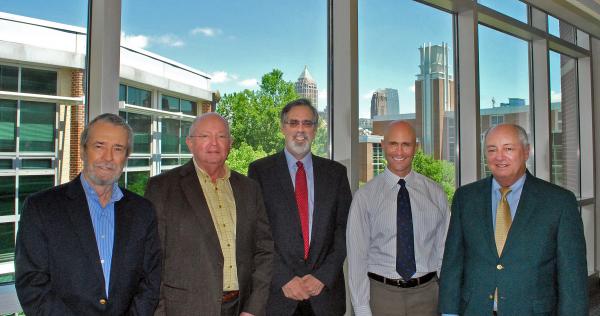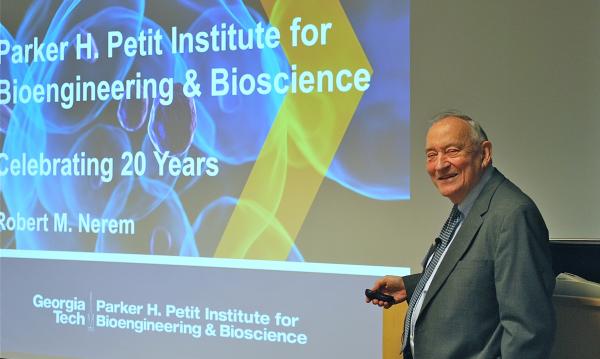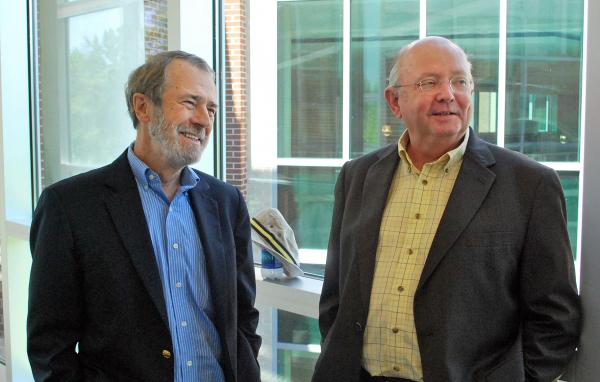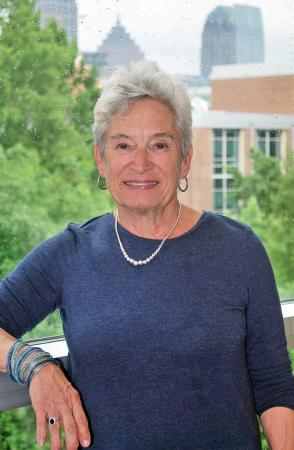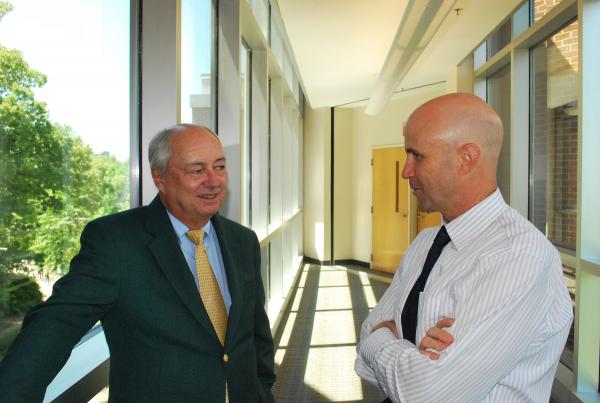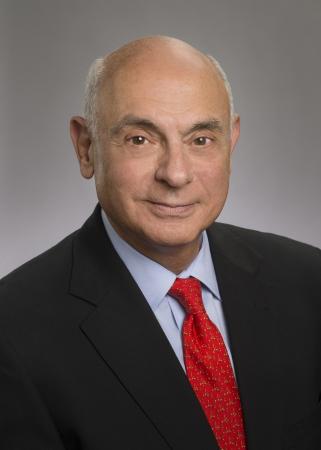Charles Darwin, whose influence on modern scientific thought cannot be underestimated, wrote, “In the long history of humankind (and animal kind, too) those who learned to collaborate and improvise most effectively have prevailed.”
Though he couldn’t have known it at the time, Darwin was describing the kind of enlightened (and evolved) self-interest that can also be found in a manmade entity such as the long bio-research partnership between the Georgia Institute of Technology (with its multidisciplinary engineering heft) and Emory University (with its sprawling medical school and clinical research capacity).
It’s a partnership that has produced biomedical discoveries for decades, one of the most dramatic being the recent successful human clinical trial of a microneedle patch for flu vaccines, a project headed up for years by Georgia Tech researcher Mark Prausnitz, whose own appraisal echoed Darwin’s 19th century assertion: "From the very start of this project, our team at Georgia Tech has been working with the Emory team to develop the microneedle patches,” Prausnitz said. “And the success of the project has been due to the strong collaboration between Georgia Tech engineers and the bioscience and medical experts at Emory."
* * *
The Georgia Institute of Technology and Emory University are connected by twisting ribbons of asphalt, five or six miles long depending on your destination. It’s a route that Bob Guldberg, executive director of the Petit Institute for Bioengineering and Bioscience at Georgia Tech, knows really well.
“When I started I was going to Emory almost every day for my in vivo studies, and to be honest, if it wasn’t for Emory, I would not be at Georgia Tech,” says Guldberg, who came to Atlanta fresh from the University of Michigan in 1996, and has been a grateful beneficiary and influential proponent of another kind of connection between the two universities – a longstanding, ever-evolving biomedical research partnership.
Guldberg arrived as an up and coming leader in orthopedic musculoskeletal research, which didn’t really have a presence at Georgia Tech at the time, “but there were potential collaborators in orthopedics at Emory," he says.
So he joined the unique and growing research partnership that existed between a private university (Emory) and a public one (Tech).
A year after Guldberg arrived, that partnership took a bold and historic step with the creation of a new academic unit. The Wallace H. Coulter Department of Biomedical Engineering (BME, launched in 1997) was the result of several things converging in the ecosystems of Emory and Georgia Tech.
This joint academic department formally linking private and public institutions is the first of its kind and rated among the best in the world. BME was the organic offspring of earlier developments, such as the Emory/Georgia Tech Biomedical Technology Research Center and its seed grant program, which nurtured an expanding faculty interest in collaborative research when it was established in 1987.
“That seed grant program was absolutely essential and its influence on success of the Emory-Georgia Tech partnership can’t be underestimated,” says Bob Nerem, founding director of the Petit Institute, which launched in 1995. “It provided a foundation for everything else that has taken place since.”
Airport Diplomacy
As Mike Johns remembers it, a conversation in 1996 on an airport escalator with Nerem ultimately led to the creation of a joint BME department. Johns had recently been named executive vice president director of Emory’s Woodruff Health Sciences Center and CEO of its Healthcare System.
Nerem had been at Georgia Tech since 1987, playing a leading role in growing the collaborative bioengineering research efforts between the two universities. Now he was settling into his role as director of the fledgling Petit Institute, a multidisciplinary research center that strengthened the bond between Georgia Tech and Emory, with its faculty from both universities and focus on a team approach.
Johns and Nerem had been attending a meeting in Washington, D.C., “and as we were coming up the escalators I said, ‘Hey, Bob, I really think Emory and Georgia Tech need to come together and form a biomedical engineering department. We don’t have an engineering school and you guys don’t have a medical school. This is something we can do together,’” Johns recalls.
So Nerem put him in touch with Georgia Tech’s provost at the time, Mike Thomas. “We agreed that if we were going to do something in any formal way, we needed a task force and that the logical person to lead it was Don Giddens,” says Nerem. “We had to bring him back from Hopkins to Atlanta.”
Giddens left Georgia Tech in 1992 to become Dean of Engineering at Johns Hopkins University, where he worked closely with Mike Johns, who had been dean of the Johns Hopkins School of Medicine.
“The opportunity to work with Mike Thomas and Mike Johns and build this thing from scratch was very appealing,” says Giddens, who led the task force through the summer of 1997. The team wrapped up its report and sent its recommendations to the Georgia Board of Regents, as well as Emory’s Board of Trustees. “Then things started moving very quickly.”
By September, the department was approved, Giddens was named as its inaugural chair, and a new era of collaboration had begun.
Team Bioscience
In 1889, an Emory graduate and former Emory president, Isaac Stiles Hopkins, became Georgia Tech’s first president. Then it took almost a hundred years for the two institutions to embark on an official partnership. When that happened, bioengineering and biomedical research were the sparks.
Interest in applying engineering principles to biomedical research was percolating at Georgia Tech by the mid 1970s, Giddens says.
“It was people like myself, Ray Vito, Ajit Yoganathan, Art Koblasz, and a couple of others,” recalls Giddens, who eventually became dean of Georgia Tech’s College of Engineering (2002-2011). “A lot of that interest was clustered within the ‘mechanics department,’ which no longer exists, and electrical engineering. Georgia Tech faculty would interact and collaborate with Emory faculty.”
Giddens was among the researchers who banded together to form the Georgia Tech Bioengineering Center, “which was kind of a key cornerstone for building the rest of what’s happened,” says Giddens. He and his colleagues had some ideas about research and education opportunities between the two universities. “One of the first things we did was to approach Emory,” Giddens adds.
Bill Todd, a Georgia Tech graduate who was Emory’s assistant vice president of health affairs at the time, remembers getting a call from his boss, Charles Hatcher (Johns’ predecessor at Emory). Hatcher had been talking to Georgia Tech’s Vice President for Research Tom Stelson, and he reached out to Todd, who recalls, “He said, ‘Georgia Tech and Emory have been talking for years about collaborating in a more formal way. Everybody says the right words, but we’ve got to do something deliberate.’ He told me to connect with Don Giddens, and leadership at both schools promised support and money to move forward in a structured, intentional way.”
The way forward led to the establishment in 1987 of the Emory/Georgia Tech Biomedical Technology Research Center and the influential seed grant program.
“That was our venture into the first phase of the Georgia Tech-Emory relationship on a formal basis,” says Yoganathan, Regents professor and Wallace H. Coulter Distinguished Faculty Chair in Biomedical Engineering. “And I’m not even sure if ‘venture’ is the right word. Maybe ‘adventure’ is correct, because we were really trying out something new.”
Todd and Giddens understood the potential of collaborative research between the two universities – one a hotbed of bioengineering and biomedical research, the other home to one of the nation’s leading medical schools and healthcare systems. So they devised a seed grant that required faculty from both institutions to work together.
“That seed grant was catalytic in getting researchers to move into the biomedical research environment,” notes Wayne Alexander, former chair of Emory’s Department of Medicine.
One of those researchers was Nerem, who came to Georgia Tech after being recruited from the University of Houston, where he chaired the Department of Mechanical Engineering. “One of the main attractions for me coming to Georgia Tech was the fact that the seed grant had been set up,” Nerem says.
Years later, Nerem’s successor at the Petit Institute could say the same thing. Guldberg credits the program with catalyzing his sustained collaborative research with Emory’s Bob Taylor (division director of cardiology). “Our initial $25,000 Georgia Tech/Emory seed grant led to four funded multi-investigator R01 awards from NIH, probably totaling about $10 million in funding,” he says. Just as importantly, it’s helped train the next generation of investigators. For example, there’s Craig Duvall, co-advised as a student by Guldberg and Taylor, and now an associate professor of BME at Vanderbilt, working on NIH-funded research.
The seed grant experience was also particularly educational for Todd, who took the idea with him when he became the founding president and CEO of the Georgia Research Alliance in 1990. “The Emory-Georgia Tech program was illustrative to me as we set up the GRA, because we were learning things – learning how to navigate the complexities of a joint venture, when two parties have their own sets of needs,” says Todd, now professor of practice in the Scheller College of Business at Georgia Tech.
Academic Standing
While the Georgia Tech/Emory seed grant program helped spur collaborative research, the two schools focused on academic pursuits, another objective of the biomedical research center, and began attracting the interest of major donors, like the Whitaker Foundation.
In 1993 the Emory-Georgia Tech partnership secured one of just three Whitaker Foundation Biomedical Engineering Program Development grants, which supported development of a Ph.D. program in bioengineering (BioE). The first faculty member recruited through that grant was Mark Prausnitz, the microneedle patch leading researcher, a long-time member of the Petit Institute who now holds the J. Erskine Love Chair in the School of Chemical Biomolecular Engineering.
Under Yoganathan’s guidance, the multidisciplinary BioE program soon became one of the top rated academic programs of its kind in the nation. Then, with the creation of the BME department in 1997 (it wasn’t named for Wallace H. Coulter yet), began a push to develop new academic programs, including graduate degrees in BME awarded jointly.
While he was dean of engineering at Johns Hopkins, Giddens guided the top ranked biomedical engineering department in the U.S. When he returned to Atlanta, he was charged with building a department from the ground up. The BME task force led by Giddens that summer of 1997 pitched the idea to Emory’s trustees, writing, “There is every reason to believe that Atlanta can be a national center for biomedical research and education if our two institutions pool capabilities. On the other hand, failure to act decisively at this time may create a handicap that will be difficult to surmount.”
They acted decisively, both Emory’s trustees and the University System of Georgia’s Board of Regents (which governs public universities, like Georgia Tech), approving the department in a matter of weeks.
The plan was to hire 15 to 18 new faculty within five years, and create a brand new graduate program. That task fell into Yoganathan’s capable hands, so he led the effort to map out a joint Ph.D. program in biomedical engineering, which was approved in 1999, while Paul Benkeser (currently senior associate chair of BME) led development of the undergraduate program. Students began enrolling in both programs in 2000, the same year the Whitaker Foundation granted a $16 million leadership development award.
“We knew the Whitaker Foundation wanted to support an undergraduate program,” Giddens says. “Their belief was that by developing an undergrad program, you ensure the permanence of the discipline.”
In 2001 the Georgia Tech/Emory Department of Biomedical Engineering was renamed for Wallace H. Coulter (one of the influential engineers of the 20th century, who shaped the fields of automated cell analysis and hematology) when the Coulter Foundation committed $25 million to the department. The gift supported a department chair, faculty chairs at Georgia Tech and Emory, labs, graduate fellowships, undergraduate clinical education, and the Coulter Endowment for Translational/Clinical Research.
Learning Science
Early on in the life of the Emory-Georgia Tech BME venture, Giddens made one of the most significant moves of his career: he brought Wendy Newstetter, a learning scientist, to the department.
“I’d become aware of the cognitive and learning scientists that were working at Georgia Tech in the College of Computing and thought that since we were going to build a curriculum, undergraduate and graduate, maybe we could get them interested in collaborating and using us as guinea pigs,” Giddens says.
That move began a culture of innovation in education that still fuels the department today, according to Joe Le Doux, one of BME’s first faculty hires, and now the department’s associate chair of undergraduate learning and experience.
“Don had the foresight and vision for what BME could become as a major and as a discipline,” Le Doux says. Hiring a learning scientist like Newstetter, “was a bold move and made the statement that education and learning was a top priority in our program.”
Newstetter, now director of learning science research for the College of Engineering, developed a new way of teaching engineering based on problem-based learning (PBL), “a pedagogical approach that came from medical school, that we adapted to a biomedical engineering environment,” she says. “We were able to observe classes at Emory, which uses problem-based learning, and figure out what we wanted it to look like at Georgia Tech.”
They created an environment for undergraduate students that emphasized collaboration over competition, immersing students in real-world, complex problems. As student enrollment soared and faculty resources were stretched thin, grad students and post docs (and later, upper classmen among the undergrads) were recruited to serve as PBL facilitators.
There were no BME textbooks at the undergraduate level. “There was no curriculum that could be considered the curriculum for BME,” notes Larry McIntire, who became chair of the department after Giddens vacated the post to become dean of the College of Engineering. “We were fortunate to have some very creative people.”
The curriculum has evolved but the focus is still on PBL, more than ever. There are fewer lecture courses now in BME, and more design courses. The BME curriculum continues to get rave reviews nationally, which is manifested in annual department rankings. Over time, both the graduate and undergraduate programs have climbed in the rankings with the undergraduate program currently listed No. 1 on the U.S. News and World Report annual rankings and the graduate program No. 3.
“Innovative, problem-focused learning has always been part of our departmental DNA,” says Ross Ethier, a Petit Institute researcher and Georgia Research Alliance Eminent Scholar who became interim chair of BME after Ravi Bellamkonda left the post to become dean of engineering at Duke University the summer of 2016. “We’ve always encouraged our students to be fearless in their approach to complicated problems, not to be constrained by preconceived notions about what is or isn’t too difficult. We have worked hard to inculcate that mindset in students, so that they can go out there and do the things that will change the world, quite frankly.”
Beyond Borders
The Georgia Tech-Emory partnership gained further momentum in 1998 when the National Science Foundation awarded $12.5 million for establishment of the Georgia Tech/Emory Center for the Engineering of Living Tissues (GTEC). Headed by Nerem, that joint research center has evolved into its current incarnation, the Regenerative Engineering and Medicine research center, a collaboration of Emory, Georgia Tech, and the University of Georgia.
Two years later, success followed success as Emory and Georgia Tech, with support from the GRA, created EmTech Bio, a biotech incubator with lab space and scientific equipment for start-up and early-stage companies on the Emory Briarcliff campus.
Through the first decade of the 21st century, the Georgia Tech-Emory partnership continued to attract large grants, especially from the National Institutes of Health, for nanotechnology research. In 2004, NIH made awards totaling $10 million to launch a multidisciplinary research program in cancer nanotechnology.
In 2005, the National Cancer Institute of NIH awarded $19 million to the two universities for the creation of the Emory-Georgia Tech Nanotechnology Center, one of seven National Centers of Cancer Nanotechnology Excellence. That same year, NIH awarded Tech and Emory scientists $11.5 million for a new program to create advanced nanotechnologies aimed at detecting and analyzing plaque at the molecular level.
“Our researchers were doing cutting edge research in nanotechnology before nanotechnology was being done by everyone. It brought us some high profile grants and gave us a lot of visibility in the scientific community,” says McIntire, who came to Georgia Tech from Rice University in 2003, as the U.A. Whitaker Building (home of BME on the Tech campus, next door to the Petit Institute) was still getting its final touches, while over at Emory, labs and offices were renovated for BME in the Woodruff Memorial Research Building.
In 2007, the NIH awarded more than $31 million over five years to a partnership that included Emory, Tech, the Morehouse School of Medicine, and Children’s Healthcare of Atlanta. The partnership focused on accelerating the translation of lab discoveries into healthcare innovations for patients. The result is the Atlanta Clinical and Translational Science Institute (ACTSI).
Biomedical Bridge
Ravi Bellamkonda, who was the third Coulter Department chair (2013-2016) always thought of BME as, “the firm, successful bridge between the two universities, a corridor that links Georgia Tech and Emory.”
BME remains one of a number of powerful links between Emory and Tech, whose partnership continues to draw major support, such as the $15.7 million grant from the Atlanta-based Marcus Foundation in early 2016 to create the Marcus Center for Therapeutic Cell Characterization and Manufacturing (MC3M) on the Georgia Tech campus.
Directed by Petit Institute researcher and BME Professor Krishnendu Roy, the new center will partner with institutions around the country, such as Emory and the University of Georgia, among others.
Meanwhile, leadership at both universities envision even more of this kind of high-octane collaboration. It’s vital. What used to be a pioneering notion has become something of a necessity.
“Team science is increasingly a strategic goal for our researchers and is certainly a focus of our federal funders,” says David Stephens, interim dean of Emory’s School of Medicine and vice president for research, Woodruff Health Sciences Center. “The Emory-Georgia Tech partnership is perfectly suited for that. So I’d like to see even more emphasis on team science, involving a broader group of faculty in more areas of health care.”
The two schools began a new chapter with the announcement in May that Susan Margulies had been named chair of the Coulter Department (and a GRA Eminent Scholar in Injury Biomechanics). Currently a professor of bioengineering at the University of Pennsylvania, Margulies is the fourth chairperson and first woman to head what is now the largest BME department in the country with more than 1,500 undergraduate and graduate students.
“Dr. Margulies will be an outstanding addition and leader for our joint department of biomedical engineering,” says Stephens. “Throughout her career, she has distinguished herself as an educator, scientist, mentor, and a national and international leader in the biomedical sciences, and I look forward to working with her in our many shared initiatives.”
Although the leadership has changed over the years, one constant has been the continual commitment to the Georgia Tech/Emory partnership. In January of this year, Jon Lewin, the president, CEO, and chairman of Emory Healthcare visited Georgia Tech for a half day discussion of the partnership history and future opportunities.
Lewin envisions an expansion of BME, as well as regenerative medicine and immuno-engineering research, “and embracing new joint programs in critical areas of medicine, such as cancer and neuroscience, and emerging fields of antibiotic resistance and the microbiome, as well as precision medicine – taking advantage of health care informatics and big data is an obvious area of future collaboration,” he says.
“I believe we can have an even greater impact on advancing biomedical research generally and on patient outcomes here in Atlanta and globally,” adds Lewin. “We also can jointly continue to impact the economies of Atlanta and Georgia through research dollars, faculty recruitment, retention of talented graduates, and startup companies. I see an even brighter future for our partnership.”
Media Contact
Jerry Grillo
Communications Officer II
Parker H. Petit Institute for
Bioengineering and Bioscience
Keywords
Latest BME News
Jo honored for his impact on science and mentorship
The department rises to the top in biomedical engineering programs for undergraduate education.
Commercialization program in Coulter BME announces project teams who will receive support to get their research to market.
Courses in the Wallace H. Coulter Department of Biomedical Engineering are being reformatted to incorporate AI and machine learning so students are prepared for a data-driven biotech sector.
Influenced by her mother's journey in engineering, Sriya Surapaneni hopes to inspire other young women in the field.
Coulter BME Professor Earns Tenure, Eyes Future of Innovation in Health and Medicine
The grant will fund the development of cutting-edge technology that could detect colorectal cancer through a simple breath test
The surgical support device landed Coulter BME its 4th consecutive win for the College of Engineering competition.

